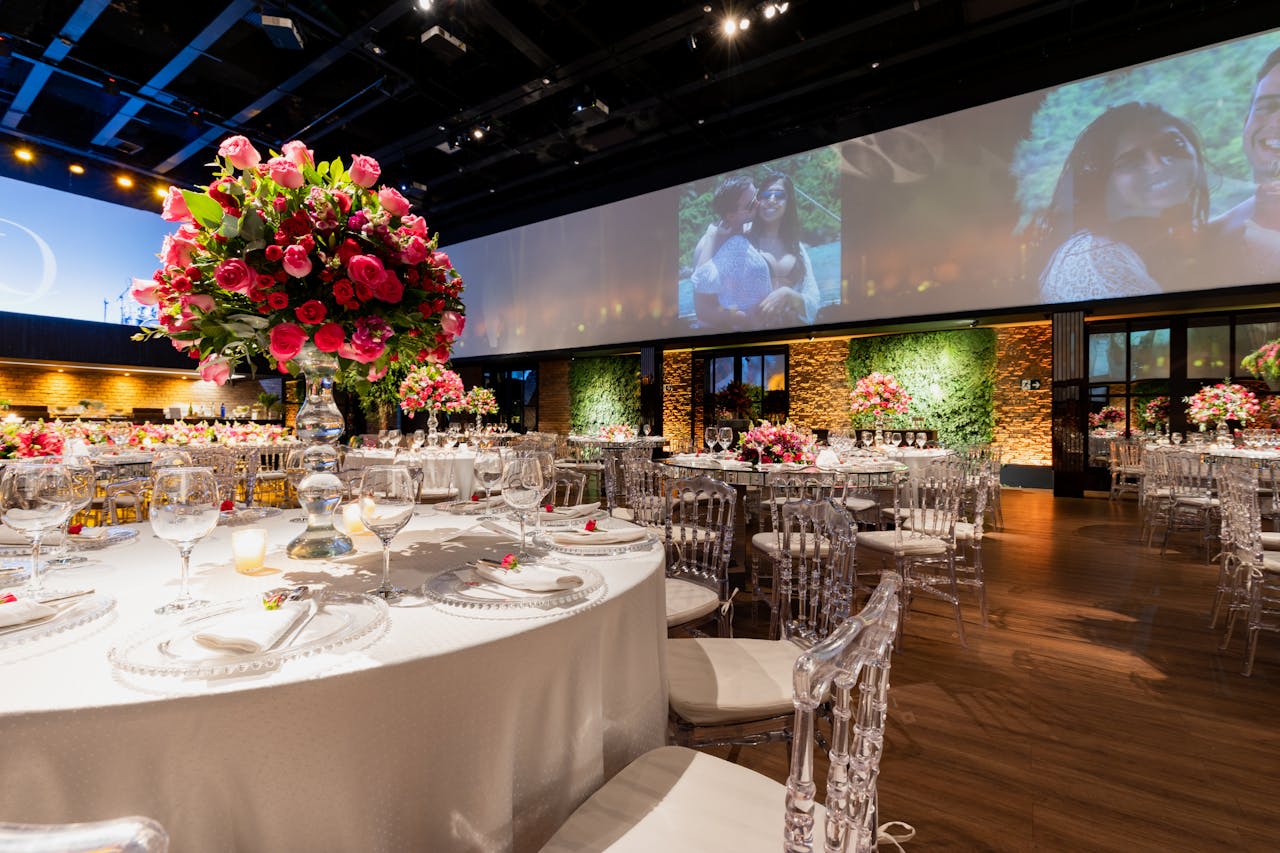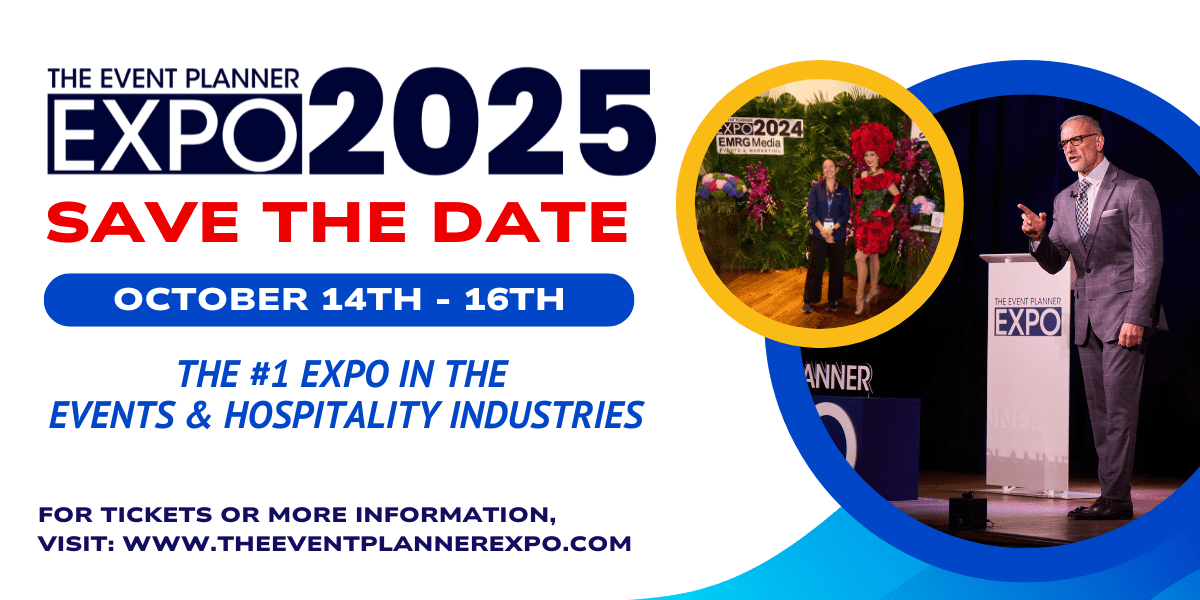The Psychology of Event Design: How Colors, Lighting & Layout Influence Guests

As an event planner, some of your event design direction may come from the client. Maybe it’s an NBA-themed mitzvah or a corporate branded team-building event, as an example. But there’s always room for a little creative freedom with your event designs. And this is where knowing the psychology of colors, event lighting, wayfinding, and layouts comes in especially handy.
Colors, sounds, and interactive elements shape how people feel and behave, urging them to explore, mingle, and learn with ease. Your event becomes more than a gathering. It becomes an orchestrated journey that resonates long after the final applause. Explore how you can master the emotional connections side of event planning and, in a way, become an event planning scientist.
Understanding Event Layout Psychology
Event layout psychology looks at how spatial design subtly influences guest behavior and engagement. Proxemics, crowding, wayfinding, and social facilitation form key elements that shape interactions in any event space.
Attendees are just going to interact more openly if they feel at ease within comfortable distance ranges. So consider seating clusters or flexible lounge areas that invite casual conversation. Crowding perceptions rise if pathways are too narrow or exhibit bottlenecks, so maintain clear walkways for stress-free movement.
Attendees navigate more confidently if signage is intuitive, so define zones with color-coding or simple visual markers. Group energy often increases if individuals see others participating close by. So keep the dance floors and interactive stations front-and-center.
🏛️ Optimizing Layout for Maximum Engagement
The physical arrangement of your event space influences how guests interact, network, and move throughout the venue.
-
-
- Open & Flowing Layouts 🚶♂️ – Encourage mingling and organic networking with strategically placed seating and activity zones.
- Zoning & Segmentation 🎭 – Create designated areas for learning, networking, dining, and entertainment to enhance organization and attendee experience.
- Strategic Seating Arrangements 🪑 – Optimize engagement by placing VIPs, speakers, and high-energy participants near focal points.
- Interactive Stations & Touchpoints 🎟️ – Encourage engagement with activations, photobooths, and experiential brand moments.
- Wayfinding & Signage 🛑 – Ensure guests can navigate the space easily with clear signage and digital guides.
-
📌 Pro Tip: Use floor plans that maximize movement and create natural gathering points to keep energy high and interactions seamless.
Strategies for Designing Networking-Friendly Spaces
Encourage natural, organic interactions that lead to meaningful connections. Use distinct zones and purposeful design cues like these.
Creating Flow and Movement Patterns
Design wide, clear walkways that link key areas. Place directional prompts near junctions if the venue has multiple breakouts. Encourage exploration by adding curved or angled paths that reveal new zones as attendees move.
Incorporate Social Spaces at Conferences
Set aside lounge-style seating areas with sound-absorbing materials to reduce noise. Create themed spots for small-group discussions if the event covers varied interests. Offer interactive features like photo stations or live demos that spark conversations.
Balance Open Areas and Intimate Corners
Leave open spaces for quick meet-and-greets. Provide quiet corners for introverts seeking one-on-one chats if your event includes diverse personality types. Reserve some structured networking zones where attendees can connect on shared topics.
Use Furniture Arrangements for Engagement
Use high-top tables for standing conversations. Cluster movable chairs in small groups to facilitate spontaneous interactions. Include modular seating systems if flexibility is a priority for shifting crowd dynamics.
Implement Crowd Flow Management Techniques
Create multiple entry and exit points to prevent blockages. Mark pathways with floor signs if you expect heavy foot traffic. Add buffer zones near popular exhibits so attendees can pause or chat without disrupting flow.
Optimize Events with Brilliant Lighting
Lighting does more than illuminate a space—it directs attention, creates ambiance, and enhances engagement. Here’s how to use lighting effectively:
-
-
- Warm Lighting 🔆 – Creates an inviting and cozy environment, great for intimate gatherings and networking events.
- Cool Lighting ❄️ – Boosts focus and professionalism, making it ideal for conferences and educational sessions.
- Dynamic Lighting Effects 🌈 – Color-changing LEDs and projections can transform a venue and enhance themed events.
- Spotlighting & Stage Lighting 🎤 – Draws attention to keynote speakers, panels, and performances.
- Uplighting & Gobo Patterns ✨ – Adds depth and branding elements to event spaces.
-
📌 Pro Tip: Use layered lighting techniques to transition moods throughout the event, from high-energy openings to relaxed networking sessions.
How Colors Shape Event Atmospheres
Color always has a direct impact on emotions and perceptions. It sets the mood and reinforces brand messaging, making it an essential (and creative) tool for event planners.
-
-
- Red 🔴 – Energizing, bold, and attention-grabbing; great for high-energy networking events and product launches.
- Blue 🔵 – Calming and trustworthy; ideal for corporate conferences and professional seminars.
- Yellow 🟡 – Optimistic and creative; perfect for innovation workshops and team-building events.
- Green 🟢 – Refreshing and balanced; excellent for wellness retreats and sustainability-focused events.
- Purple 🟣 – Luxurious and imaginative; best for gala events and high-end brand activations.
- Gold ✨ – Elegant and prestigious; perfect for award ceremonies and luxury brand events.
- Black ⚫ – Sophisticated and powerful; ideal for upscale galas, VIP gatherings, and exclusive nightlife events.
- White ⚪ – Clean and modern; great for minimalist event designs, weddings, and futuristic brand experiences.
-
📌 Pro Tip: Use color strategically in branding, stage design, and decor to reinforce the intended emotional response from guests.
Event Planning Inspiration at The Expo
Become an event scientist! By mastering color psychology, lighting techniques, and spatial design, you can create unforgettable events.
Need help implementing these elements in your next corporate event? Connect with top event designers and planners at The Event Planner Expo 2025! Showcase your own expertise, too, as a high-value exhibitor on the tradeshow floor. Reserve your spot while booth spaces are still available!
FAQs About Event Layout, Color, and Lighting
Why is focusing on emotions vital in event design?
A well-designed event taps into people’s emotions, creating an immersive atmosphere. Simple choices, like warm lighting, thought-out signage, and friendly staff, can spark positive feelings. These emotional connections make attendees feel more valued and engaged.
How does layout psychology impact attendee engagement?
Layout psychology analyzes how physical space influences behavior, focusing on factors like proxemics, crowding, and clear pathways. When attendees feel at ease moving around, they’re more likely to explore and engage. Thoughtful design choices, like comfortable seating, open walkways, and intuitive signage, reduce stress and encourage participation.
What design strategies encourage networking at events?
Create distinct zones for various interaction levels and include purposeful visual cues. Provide wide walkways and friendly signage to guide attendees toward communal spaces, such as lounges or themed discussion areas. Mixing open spaces for casual encounters with intimate corners for personal chats suits different personality types. Offer versatile furniture like high-top tables and movable chairs to spark spontaneous gatherings. With clear design prompts, you make it easy for people to connect.
Why is it important to test event layouts?
A/B tests help identify successful elements, like on-site signage or seating arrangements, so you can refine the layout over time. Ongoing evaluation helps you adapt quickly, making your event more memorable and effective at meeting your goals.
How does lighting influence the event atmosphere?
Lighting sets the tone and mood of any space. Warm, soft lights can make guests feel relaxed and welcomed, while brighter lighting can energize them. Thoughtful lighting choices can guide people to focal points, highlight sponsor areas, or accent important features like stages and displays. When used strategically, lighting engages attendees’ senses and supports the overall theme, encouraging a positive experience that stays with them long after the event.
What are some ways to manage crowd flow effectively?
Start with multiple entry points to disperse arrivals and reduce bottlenecks. Use clear signage and visible pathways so attendees know where to go. Keep areas like walkways and lounges open and comfortable, making it easier for people to move around. Consider placing refreshment stations far apart to prevent congestion. With good crowd flow management, you create a smoother attendee experience, reduce stress, and encourage greater participation throughout the event space.
How can I measure the success of my event layout?
Gather data through attendee surveys, observation, and social media mentions. Check for bottlenecks and see if people freely interact in designated networking areas. Use A/B testing to compare different design choices, for example, altering seating setups or relocating refreshment stations, and measure changes in attendee engagement. Additionally, collect feedback from staff, sponsors, and participants on what worked or can be improved. These insights help you fine-tune and optimize future event layouts.
